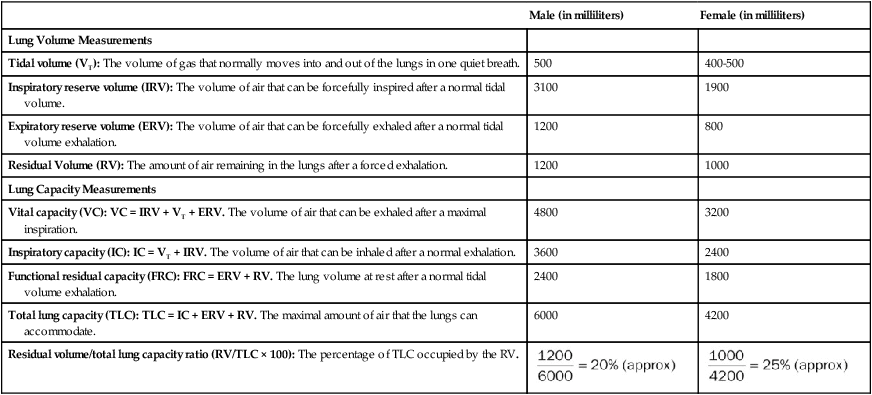After reading this chapter, you will be able to: • Describe the following lung volumes and capacities: • Inspiratory reserve volume (IRV) • Expiratory reserve volume (ERV) • Functional residual capacity (FRC) • Residual volume/total lung capacity ratio (RV/TLC) • List the normal lung volumes and capacities of normal recumbent subjects who are 20 to 30 years of age. • Identify lung volumes and capacity findings characteristic of restrictive lung disorders. • Describe the anatomic alterations of the lungs associated with restrictive lung disorders. • Identify lung volumes and capacity findings characteristic of obstructive lung disorders. • Describe the anatomic alterations of the lungs associated with obstructive lung disorders. • List the indirect measurements of the residual volume and lung capacities containing the residual volume. • Describe expiratory flow rate and volume measurements and their respective normal values: • Forced expiratory volume timed (FEVT) • Forced expiratory volume in 1 second/forced vital capacity ratio (FEV1/FVC) • Forced expiratory flow at 25% to 75% (FEF25%-75%) • Forced expiratory flow at 50% (FEF50%) • Forced expiratory flow between 200 and 1200 mL of FVC (FEF200-1200) • Peak expiratory flow rate (PEFR) • Maximum voluntary ventilation (MVV) • Describe how the FVC, FEV1, and FEV1/FVC are used to differentiate restrictive and obstructive lung disorders. • Identify forced expiratory flow rate findings characteristic of restrictive lung disorders. • Identify forced expiratory flow rate findings characteristic of obstructive lung disorders. • Describe the pulmonary diffusion capacity (Dlco). • Identify Dlco findings characteristic of restrictive lung disorders. • Identify Dlco findings characteristic of obstructive lung disorders. • Define key terms and complete self-assessment questions at the end of the chapter and on Evolve. As shown in Table 3-1, gas in the lungs is divided into four lung volumes and four lung capacities. The lung capacities represent different combinations of lung volumes. The amount of air the lungs can accommodate varies with age, weight, height, gender, and, to a much lesser extent, race. Prediction formulas for normal values exist that take these variables into account. Lung volumes and capacities change as a result of pulmonary disorders. These changes are classified as either restrictive lung disorders or obstructive lung disorders. Table 3-1 Lung Volumes and Capacities of Normal Recumbent Subjects 20 to 30 Years of Age Table 3-2 presents an overview of the lung volume and capacity findings characteristic of restrictive lung disorders. Restrictive lung volumes and capacities are associated with pathologic conditions that alter the anatomic structures of the lungs distal to the terminal bronchioles (i.e., the alveoli or the lung parenchyma). Table 3-3 provides some of the more common restrictive anatomic alterations of the lungs and examples of respiratory disorders that cause them. Restrictive lung disorders result in an increased lung rigidity, which in turn decreases lung compliance. When lung compliance decreases, the ventilatory rate increases and the tidal volume (VT) decreases (see Figure 2-23). Table 3-2 Restrictive Lung Disorders: Lung Volume and Capacity Findings Table 3-3 Table 3-4 provides an overview of the lung volumes and capacity findings characteristic of obstructive lung disorders. These lung volume and capacity findings are associated with pathologic conditions that alter the tracheobronchial tree. Table 3-5 provides some of the more common obstructive anatomic alterations of the lungs and examples of respiratory disorders that cause them.
Pulmonary Function Study Assessments
Normal Lung Volumes and Capacities
Male (in milliliters)
Female (in milliliters)
Lung Volume Measurements
Tidal volume (VT): The volume of gas that normally moves into and out of the lungs in one quiet breath.
500
400-500
Inspiratory reserve volume (IRV): The volume of air that can be forcefully inspired after a normal tidal volume.
3100
1900
Expiratory reserve volume (ERV): The volume of air that can be forcefully exhaled after a normal tidal volume exhalation.
1200
800
Residual Volume (RV): The amount of air remaining in the lungs after a forced exhalation.
1200
1000
Lung Capacity Measurements
Vital capacity (VC): VC = IRV + VT + ERV. The volume of air that can be exhaled after a maximal inspiration.
4800
3200
Inspiratory capacity (IC): IC = VT + IRV. The volume of air that can be inhaled after a normal exhalation.
3600
2400
Functional residual capacity (FRC): FRC = ERV + RV. The lung volume at rest after a normal tidal volume exhalation.
2400
1800
Total lung capacity (TLC): TLC = IC + ERV + RV. The maximal amount of air that the lungs can accommodate.
6000
4200
Residual volume/total lung capacity ratio (RV/TLC × 100): The percentage of TLC occupied by the RV.



Restrictive Lung Disorders: Lung Volume and Capacity Findings
VT
N or ↓
IRV
↓
ERV
↓
RV
↓
VC
↓
IC
↓
FRC
↓
TLC
↓
RV/TLC
N

Pathology (Anatomic Alteration of the Alveoli)
Examples of Respiratory Disorders Associated with Specific Pathology
Atelectasis
Pneumothorax, pleural effusion, flail chest, or mucous plugging
Consolidation
Pneumonia, acute respiratory distress syndrome, lung abscess, tuberculosis
Increased alveolar-capillary membrane thickness
Pulmonary edema, pneumoconiosis, tuberculosis, fungal disease
Obstructive Lung Disorders: Lung Volume and Capacity Findings
Pulmonary Function Study Assessments



